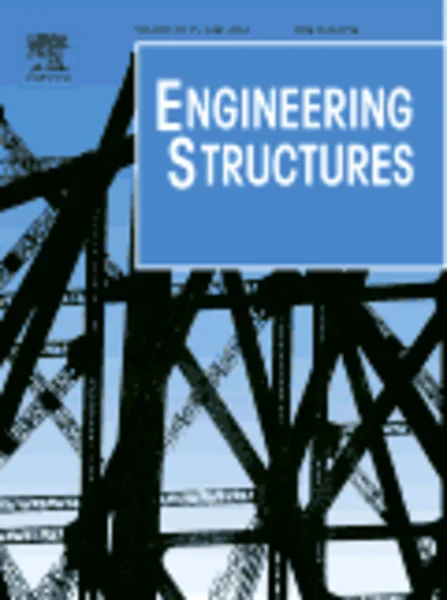-
variation of structural vibration characteristics versus non-uniform temperature distribution
جزئیات بیشتر مقاله- تاریخ ارائه: 1392/07/24
- تاریخ انتشار در تی پی بین: 1392/07/24
- تعداد بازدید: 796
- تعداد پرسش و پاسخ ها: 0
- شماره تماس دبیرخانه رویداد: -
in vibration-based condition assessment exercises, it is necessary to discriminate the variation of structural properties due to environmental changes from those caused by structural damages. some efforts have been made to correlate the structural vibration characteristics and the air temperature or temperatures at the structural surface. as the temperature of an entire structure is generally non-uniformly distributed, using the air temperature or surface temperatures alone may not sufficiently capture the relation between the structural responses and temperatures. the present paper aims to investigate the variation of the structural vibration characteristics versus the non-uniform temperature field of the structure. thermodynamic models are employed to estimate the temperature at different components of the structure at different times. as the material mechanical properties are temperature dependent, the structure can be regarded as a composite structure consisting of elements with different young’s moduli. consequently, the natural frequencies of the structure can be calculated with the finite element method. the procedures are repeated for different times and thus variation of the frequencies with respect to time is obtained. a simply supported rc slab was constructed and used as a proof-of-concept example. the temperatures at different points of the slab were recorded continuously in one day, together with a series of forced modal testing to extract its modal properties. on the other hand, a finite element model was established to conduct a transient thermal analysis and estimate the temperature distribution of the slab, which shows a good agreement with the measurement counterpart. the temperature data at all components and thermal properties of the material were then inputted to the model to calculate the frequencies, which also matched the measured frequencies very well. moreover, a good linear correlation between the natural frequencies measured and the structural temperatures other than the air temperature or surface temperatures is observed. the present study provides a new approach to quantifying the environmental effect on the structural vibration characteristics.
مقالات جدیدترین رویدادها
-
استفاده از تحلیل اهمیت-عملکرد در ارائه الگوی مدیریت خلاقیت سازمانی و ارائه راهکار جهت بهبود
-
بررسی تاثیر ارزش وجوه نقد مازاد بر ساختار سرمایه شرکت های پذیرفته شده در بورس اوراق بهادار تهران
-
بررسی تأثیر سطح افشای ریسک بر قرارداد بدهی شرکت های پذیرفته شده در بورس اوراق بهادار تهران
-
بررسی تأثیر رتبه بندی اعتباری مبتنی بر مدل امتیاز بازار نوظهور بر نقد شوندگی سهام با تأکید بر خصوصی سازی شرکت ها
-
تأثیر آمیخته بازاریابی پوشاک ایرانی بر تصویر ذهنی مشتری پوشاک ایرانی (هاکوپیان)
-
جداسازی اکسید روی از لجن واحد آگلومراسیون ذوب آهن اصفهان به روش هیدرومتالوژی
-
یک مدل شبکه دو لایه یکپارچه برای طراحی زنجیره تامین مقاوم برای اقلام فاسد شدنی تحت اختلال
-
بررسی آلودگی کفش های محیط های استریل و نیمه استریل اتاق عمل بیمارستان توحید سنندج
-
بررسی وضعیت سلامت اجتماعی در دانشجویان تربیت بدنی دانشگاه آزاد اسلامی واحد بیرجند
-
head-on collision of ion-acoustic solitons in an ultracold neutral plasma
مقالات جدیدترین ژورنال ها
-
مدیریت و بررسی افسردگی دانش آموزان دختر مقطع متوسطه دوم در دروان کرونا در شهرستان دزفول
-
مدیریت و بررسی خرد سیاسی در اندیشه ی فردوسی در ادب ایران
-
واکاوی و مدیریت توصیفی قلمدان(جاکلیدی)ضریح در موزه آستان قدس رضوی
-
بررسی تاثیر خلاقیت، دانش و انگیزه کارکنان بر پیشنهادات نوآورانه کارکنان ( مورد مطالعه: هتل های 3 و 4 ستاره استان کرمان)
-
بررسی تاثیر کیفیت سیستم های اطلاعاتی بر تصمیم گیری موفق در شرکتهای تولیدی استان اصفهان (مورد مطالعه: مدیران شرکتهای تولیدی استان اصفهان)
-
بررسی خواص فیزیکی و شیمیایی و خواص زیست تخریب پذیری و ضد میکروبی کامپوزیت پلیمرهای زیست تخریب پذیر
-
تاثیر بازاریابی کارآفرینانه بر عملکرد صادراتی با نقش میانجی دوره های آموزش ضمن خدمت ( مورد مطالعه :شرکت لبنیات پاستوریزه پاک )
-
تحلیل حقوقی نظام حقوق بین الملل در راستای مقابله با خشونت علیه زنان
-
عفو و توبه به عنوان آسیب های وارد بر قطعیت اجرای کیفر در نظام حقوقی ایران
-
adsorption of so2 and no2 on zro2 (1 1 0) surface: density functional theory and molecular dynamic simulation studies




سوال خود را در مورد این مقاله مطرح نمایید :